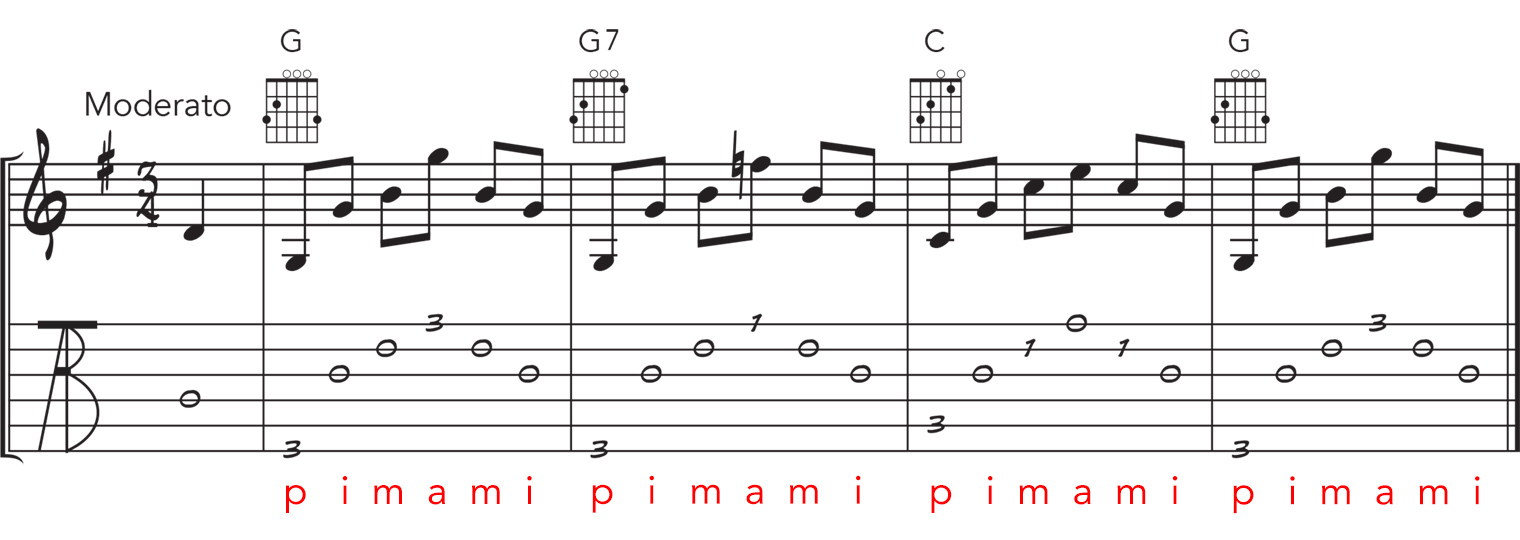|
|
|||||||||||||||
.
|
| Newton's poem was set to a song entitled New Britain, written by James Carrell, and published in the United States in Virginia Harmony (1831). That version spread like wildfire during the Second Great Awakening (c. 1800) when thousands gathered for Christian revival meetings. Here's the first verse: |
Amazing grace! How sweet the sound
That saved a wretch like me.
I once was lost, but now am found,
Was blind but now I see.
 Study Tips
Study Tips
Amazing Grace's Melody
The melody of Amazing Grace is based on the G major pentatonic scale: G, A, B, D and A. The pentatonic scale is common in both Asian and Blues styles and, indeed, the pentatonic modality of Amazing Grace lends itself to a bluesy feel.
Here's what a major pentatonic scale sounds like:
The melody is relatively easy to play, with plentiful open string notes and a familiar tune for most players. Counting out the long sustaining notes is the main challenge.
Pickup Note
Amazing Grace begins with a pickup note: count 1-2 and start the melody on the third beat. The pickup note leads into the downbeat and should be played slightly softer than the downbeat.
Amazing Grace | First two phrases (lines)

Tied Notes
The dotted half note tied to a half note in the second line (above) receives a total of five beats. Don't be shy about counting out the beat—1-2-3- | 1-2—as you sustain the tied notes. Guessing doesn't work.
The final measure of Amazing Grace has only two beats, rather than three, in order to connect seamlessly to the pickup note during the song repeat.
Meter and Tempo
To maintain the feel of triple meter, give an accent to downbeats. Practice with a metronome to shore up your beat. Aim for a tempo of about 96 BPM (andante).
Listen to the Track
Before practicing, listen to the audio track and imbue yourself with the sound of Amazing Grace. Grace plays the melody while Peter provides the P-i-m-a-m-i arpeggio in the demonstration video.
Play the Melody Now
Practice the melody of Amazing Grace until smooth. Play along with the audio track or video to help shore up your rhythm.
Amazing Grace | Melody only

Once the melody of Amazing Grace is under your fingers, work on the chord accompaniment.
 Chords
Chords
Amazing Grace contains two new chords: D7sus4 and Em7. The suffix sus4 is an abbreviation of "suspended 4th." Thus, we pronounce D7sus4 as D seven suspended four. Saying the name is harder than playing the chord!
If a chord is difficult, practice forming the chord shape—spot practice. Plant all the notes of the chord at once, not one finger at a time.
Simple Strum 3/4
The simplest possible strum accompaniment for Amazing Grace is Simple Strum 3/4. It gets it done with one strum per measure (strum every three beats). This folkloric strum is beautiful and allows space for the melody to shine.
Amazing Grace | Simple Strum 3/4 (with melody)
Flat-Three Strum
If you fancy a more active strum, the Flat-Three Strum we learned for Arirang—three gentle quarter note down strums per measure—works well and serves a quasi metronomic role. Click here to review the basics of the Flat-Three Strum.
Amazing Grace | Flat-Three Strum
P-i-m-a-m-i Arpeggio
The triple meter feel of Amazing Grace also goes great with the P-i-m-a-m-i Arpeggio we learned for Cuckoo earlier in the course. If you need a review, revisit Cuckoo's "how to" video for P-i-m-a-m-i.
P-i-m-a-m-i Arpeggio Pattern | Practice on the open strings first.

Here's what the P-i-m-a-m-i arpeggio sounds like when applied to the first phrase of Amazing Grace:

Now you're ready to put it all together, both melody and chords!
Amazing Grace | Melody and chords

Need Help?
Do you need help? Don't be shy about asking questions. For guitar issues, make an office or Zoom appointment and we'll help you figure it out.
Download | Amazing Grace PDF
 |
 |
 |
©Copyright 2024 by Peter Kun Frary | All Rights Reserved



